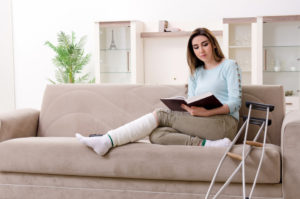The 8 Steps to Rehab and Recovery After a Car Accident
 Every car accident injury is different, but when it comes to healing, a skilled doctor will usually be able to lay out a plan for your recovery. One of the benefits of visiting an accident and injury clinic is the expertise of the providers in injuries similar to yours, but you likely want to understand the plan as well. Your provider will be able to use the severity and type of your injury for more accurate timelines and plans, but the following is a roadmap to recovery for most of our clients.
Every car accident injury is different, but when it comes to healing, a skilled doctor will usually be able to lay out a plan for your recovery. One of the benefits of visiting an accident and injury clinic is the expertise of the providers in injuries similar to yours, but you likely want to understand the plan as well. Your provider will be able to use the severity and type of your injury for more accurate timelines and plans, but the following is a roadmap to recovery for most of our clients.
1. Seek Medical Care Immediately
If you don’t know what to do after a vehicular accident, the most important thing is to visit an accident and injury clinic as soon as possible following the event. Many common injuries don’t become apparent for days after your accident, and the longer you wait, the more ability they have to worsen and require more care. Left untreated entirely, they may become chronic issues rather than things that can easily be healed.
2. Choose the Correct Provider
While your instinct may be to visit your primary care physician, you should seek out care from an expert accident and injury clinic. Not only does this cut out the extra time of referrals, but you can also be sure your care is specifically tailored to your injuries and that the provider’s experience matches your needs. Many clinics also have a range of providers, from physical therapists to neurosurgeons, to holistically treat any damage to your body.
3. Follow Your Treatment Plan
Depending on your injury, your plan may be simple, or it may be long and complex. But it is important to follow it completely, not only for your physical recovery, but also for documentation to provide your insurance company. It may be difficult to take time off work, or painful to follow through on home exercises, but the more you adhere to your plan, the better chances you have of full recovery.
4. Get Enough Rest
With any injury, rest and sleep are critical. Sleep allows your body to increase blood flow to the muscles, expediting tissue and muscle repair and growth. At the same time, stress hormones in the body drop during sleep and reduce inflammation. These processes can help the body to heal faster and avoid worsening the condition of your injury. Even when you are awake, it is important to not push yourself too hard as you heal.
5. Manage Pain and Symptoms
The goal at most accident and injury clinics will be to heal the root cause of your pain, but during the process, it is important that you manage your pain to get through the day. Prolonged periods of pain can lead you to feel hopeless or defeated, even demotivating you to continue treatment. Managing this pain may involve rest and simple remedies like hot and cold therapies. In conjunction with your car accident doctor, you can also decide what amount of pain medication is right for you to maintain function without relying solely on medication.
6. Stretch and Move Gently
While rest is critical, that does not mean you should be bedbound as you heal from an injury. Instead, you will want to focus on gentle exercises and stretches that keep the body moving without further straining the injured area. Regular movement prevents the muscles and joints from becoming stiff or weak, ultimately reducing pain and inflammation. Many accident and injury clinics will have you participate in physical therapy to help determine the best exercises for you that are safe. The strengthening of your muscles will also have the added benefit of preventing future injury.
7. Stay Hydrated and Eat Healthy
Your body needs adequate fluid to repair muscle and tissue damage, so it is critical to drink enough water throughout the day. In addition to this, you should be consuming whole and fresh foods with vitamins and nutrients. This helps the body to have the strength to repair the damage and gives you energy to feel stronger and more energetic as you heal.
8. Be Patient
For some people, this is one of the hardest steps, though it is also one of the most important. Recovery is not always linear and you may experience setbacks even after you have seen improvements, or you may simply feel that you should be improving faster. Keep in mind that everyone’s recovery looks different and the providers at your accident and injury clinic know what your body needs. Following their plan and adjusting as needed will give you the best chance at full relief.
